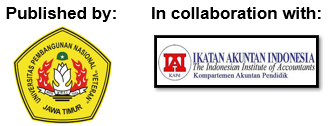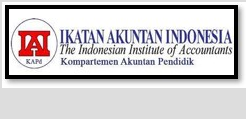Use Big Theory Clarifies Financial Performance: The Role of Internal Mechanisms Control
DOI:
https://doi.org/10.33005/jasf.v8i1.596Keywords:
Big theory, Financial performance, Integrated GRC, Internal auditAbstract
Purpose: This paper establishes the basic concepts, related work, and core propositions of implementing integrated Governance, Risk Management and Compliance (GRC), internal audit function, and financial performance through the perspective of the underlying grand theory.
Method: This paper uses literature-based analysis. First, it builds a conceptual argument by looking for the big theory, which is the leading theory that serves as the foundation for explaining and analyzing important phenomena in a field of science, which can underlie the integration of GRC, internal audit, and financial performance. It concludes with the predicted relationships of the three that can be seen through their application. Big theory is the leading theory that serves as the foundation for explaining and analyzing important phenomena in a field of science.
Findings: Based on underlying the big theory and the supporting concepts, it is proven that integrated GRC, internal audit, and financial performance are in one corridor of built relationships.
Novelty/Value: Integration of GRC, internal audit, and financial performance in one agency theory-based framework presents integrated relationships and new hypotheses, different from previous studies that separate these variables.
Downloads
References
Agyei-Mensah, B. K. (2019). The effect of audit committee effectiveness and audit quality on corporate voluntary disclosure quality. African Journal of Economic and Management Studies, 10(1), 17–31. https://doi.org/10.1108/AJEMS-04-2018-0102
Akerlof, G. A. (1970). The market for “lemons”: Quality uncertainty and the market mechanism. The Quarterly Journal of Economics, 84(3), 488–500. https://doi.org/10.1017/cbo9780511609381.002
Alazzabi, W. Y. E., Mustafa, H., & Karage, A. I. (2020). Risk management, top management support, internal audit activities and fraud mitigation. Journal of Financial Crime, July. https://doi.org/10.1108/jfc-11-2019-0147
Alqubaisi, S. S. (2018). The Role of Governance, Risk and Compliance in Successful Portfolio Project Management, International Journal of Economics, Finance and Business Management Studies, 4(2), 71–82.
Ben Fatma, H., & Chouaibi, J. (2021). Corporate governance and firm value: a study on European financial institutions. International Journal of Productivity and Performance Management. https://doi.org/10.1108/IJPPM-05-2021-0306.
Bett, C. C. (2014). The Relationship between Effectiveness of Internal Audit Function and Financial Performance of Companies Listed in Nairobi Securities Exchange. https://erepository.uonbi.ac.ke/bitstream/handle/11295/75652/Bett_The_Relationship_Between_Effectiveness_of_Internal_Audit_Function_and_Financial_Performance_of_Companies_Listed_in_Nairobi_Securities_Exchange.pdf?sequence=4
Bou-Raad, G. (2000). Internal auditors and a value-added approach: the new business regime. Managerial Auditing Journal, 15(4), 182–187. https://doi.org/10.1108/02686900010322461.
Chambers, A.D. & Odar, M. (2015). A new vision for internal audit. Managerial Auditing Journal, 30(1), 34–55.
Chun, J. S., Shin, Y., Choi, J. N., & Kim, M. S. (2013). How Does Corporate Ethics Contribute to Firm Financial Performance? The Mediating Role of Collective Organizational Commitment and Organizational Citizenship Behavior. Journal of Management, 39(4), 853–877. https://doi.org/10.1177/0149206311419662.
Chuprunov, M. (2018). Leveraging SAP GRC in the Fight Against Corruption and Fraud. https://www.google.co.id/books/edition/Leveraging_SAP_GRC_in_the_Fight_Against/NQBNDwAAQBAJ?hl=en&gbpv=1&dq=GRC+and+corruption&printsec=frontcover.
Coase, R. (1937). The nature of the firm. Economica, 4(16), 386–405. https://doi.org/https://doi.org/10.2307/2626876.
Cressey, D. R. (1950). The criminal violation of financial trust. American Sociological Review, 15(6), 738–743.
Cressey, D. R. (1953). Other People’s Money. Belmont, California: Wadsworth Publishing Company, Inc.
Davis, J. H., Schoorman, F. D., & Donaldson, L. (1997). Toward a stewardship theory of management. Academy of Management Review, 22(1), 20–47. https://doi.org/10.5465/AMR.1997.9707180258.
Dissanayake, H., Dissabandara, H., & Ajward, R. (2019). Compliance with Disclosure Principles and Financial Performance: Empirical Evidence from Sri Lankan Listed Companies. Proceedings of the 6th International Conference on Multidisciplinary Approaches (ICMA). Faculty of Graduate Studies, University of Sri Jayewardenepura. https://ssrn.com/abstract=3497536
Dittmar, L. (2007). First steps on a long journey: Towards an architected GRC System. GRC 360 (Spring): 4.
Dittmar, Lee, Llp, D. C., Vogel, P., & Manager, S. (2008). Integrating GRC with Performance Management Demands Enterprise Solutions. October 2007.
Dodge, C. (2016). Compliance Theory of Organizations. Global Encyclopedia of Public Administration, Public Policy, and Governance, 1–5. https://doi.org/DOI 10.1007/978-3-319-31816-5_3000-1
Donaldson, L. (2001). The Contingency Theory of Organizations. Sage, Thousand Oaks.
Dowling, J. & Pfeffer, J. (1975). Organisational legitimacy: Social values and organisational behavior. Pacific Sociological Review, 18(1), 122–136.
Drazin, R., & de Ven, A. H. Van. (1985). Alternative Forms of Fit in Contingency Theory. Administrative Science Quarterly, 30(4), 514–539. https://doi.org/10.2307/2392695
Dubin, R. (1976). Theory building in applied areas. Handbook of Industrial and Organizational Psychology, 17–39.
Eisenhardt, Kathleen M. (1989). Agency Theory: An Assessment and Review. Academy of Management Review, 14(1), 57–74. https://doi.org/https://doi.org/10.5465/amr.1989.4279003.
Eisenhardt, E. M. (1989). Building theories from case study research. Academy of Management Review, 14(4), 532–550.
Elbardan, H., Ali, M., & Ghoneim, A. (2015). The dilemma of internal audit function adaptation: The impact of ERP and corporate governance pressures. Journal of Enterprise Information Management, 28(1), 93–106. https://doi.org/10.1108/JEIM-10-2013-0074
Fama, E. F., & Jensen, M. C. (1983). Separation of ownership and control. Journal of Law and Economics, 26. https://doi.org/10.1086/467037
Freeman, R. E. (1984). Strategic Management: A Stakeholder Approach. Pitman Publishing Inc. https://3lib.net/md5/3B761F9CE5E44EC5C3DFAEFA7001A113
Fudenberg, D., & Tirole, J. (1991). Game Theory by Drew Fudenberg, Jean Tirole. The MIT Press, London, England.
Glaser, B. G., & Strauss, A. L. (1967). The discovery of grounded theory: Strategies for qualitative research. Chicago: Aldine.
González, S. M. (2016). Fraud prevention through segregation of duties: authorization model in SAP GRC Access Control. https://e-archivo.uc3m.es/handle/10016/23673
Halbouni, S. S., Obeid, N., & Garbou, A. (2016). Corporate governance and information technology in fraud prevention and detection: Evidence from the UAE. Managerial Auditing Journal, 31(6–7), 589–628. https://doi.org/10.1108/MAJ-02-2015-1163
Hale Feinstein, A., Mann, S., & Corsun, D. L. (2002). Charting the experiential territory:Clarifying definitions and uses of computer simulation, games, and role play. Journal of Management Development, 21(10), 732–744. https://doi.org/10.1108/02621710210448011
Hanley, J. T. (2021). GAMES, game theory, and artificial intelligence. Journal of Defense Analytics and Logistics, 5(2), 114–130. https://doi.org/10.1108/jdal-10-2021-0011
Hayes, R., & Philip Wallage and Hans Gortemaker. (2014). Principles of Auditing: An Introduction to International Standards on Auditing (3rd Edition). Pearson Education Limited.
Hazaea, S. A., Tabash, M. I., Zhu, J., Khatib, S. F. A., & Farhan, N. H. S. (2021). Internal audit and financial performance of Yemeni commercial banks: Empirical evidence. Banks and Bank Systems, 16(2), 137–147. https://doi.org/10.21511/bbs.16(2).2021.13
Hernández-Lara, A. B., Serradell-López, E., & Fitó-Bertran, À. (2019). Students’ perception of the impact of competences on learning: An analysis with business simulations. Computers in Human Behavior, 101, 311–319. https://doi.org/10.1016/j.chb.2019.07.023
Hyland, M. M., & Verreault, D. A. (2003). Developing a strategic internal audit-human resource management relationship: A model and survey. Managerial Auditing Journal, 18(6/7), 465–477. https://doi.org/10.1108/02686900310482614
Institute of Internal Auditors. (2020). The IIA’s Three Lines Model: An update of the Three Lines of Defense. https://www.theiia.org/en/content/position-papers/2020/the-iias-three-lines-model-an-update-of-the-three-lines-of-defense/
Irene, M., Bunyasi, G., & Muchiri. (2017). Effects of risk assessment and internal audit standards on financial performance of state-owned corporations in Kenya: a case study of the Ministry of Labor, Social, and Security Services. Journal of Finance and Accounting, 1(1), 1–13.
Isidro, H., & Sobral, M. (2014). The Effects of Women on Corporate Boards on Firm Value, Financial Performance, and Ethical and Social Compliance. Journal of Business Ethics, 132(1), 1–19. https://doi.org/10.1007/s10551-014-2302-9
Jensen, Michael C. & William H. Meckling. (1976). Theory of The Firm: Managerial Behavior, Agency Costs, and Ownership Structure. Journal of Financial Economics, 3, 305–360. https://doi.org/https://doi.org/10.1016/0304-405X(76)90026-X
Jones, E. E., & Davis, K. E. (1965). From acts to dispositions: the attribution process in social psychology, in L. Berkowitz (ed.), Advances in experimental social psychology. New York: Academic Press.
Jones, E., & Davis, K. (1965). From acts to dispositions: the attribution process in social psychology. Advances in Experimental Social Psychology, 2, 219–266.
Jones, G. R. & George, J. M. (2016). Contemporary Management. In New York: McGraw-Hill Education, 2 Penn Plaza. New York. http://www.gbv.de/dms/zbw/795492227.pdf
Kahneman, D., & Tversky, A. (1979). Prospect Theory: An Analysis of Decision Under Risk. Econometrica, 47(2), 263–291. http://web.mit.edu/curhan/www/docs/Articles/15341_Readings/Behavioral_Decision_Theory/Kahneman_Tversky_1979_Prospect_theory.pdf
Kaplan, A. (1965). The Conduct of Inquiry: Methodology for Behavioral Science. Oxford University Press, 44(1), 126–127. http://www.jstor.org/stable/2574840
Kelly, K. C., & Dokubo, K. (2021). Internal Audit Function and Financial Performance of Telecommunication Firms in Nigeria. Nigerian Journal of Management Sciences, 22(1), 151–164.
Kwabena, K. A. (2017). Effects of internal audit quality on the financial performance of firms listed in the Nairobi Securities Exchange. Thesis. http://erepository.uonbi.ac.ke/bitstream/handle/11295/103033/Kwabena_The_Effects_of_Internal_Audit_Quality.pdf?sequence=1&isAllowed=y
Lau, C. M. J. N. (2003). The Influence of Organisational Commitment on the Use of Financial Measures for Performance Evaluation. In Pacific Accounting Review (Vol. 15, Issue 1).
Lawrence, P., & Lorsch, J. (1967). Differentiation and Integration in Complex Organizations. Administrative Science Quarterly, 12(1), 1–47.
Limperg, T. (1932). Theory of Inspired Confidence. Amsterdam. University of Amsterdam.
Lynham, S. A. (2000). Theory building in the human resource profession. Human Resource Development Quarterly, 11(2), 159–178.
Maulidi, A., & Ansell, J. (2020). The conception of organisational fraud: the need for rejuvenation of fraud theory. Journal of Financial Crime, 28(3), 784–796. https://doi.org/10.1108/JFC-09-2020-0180
Meyer, J. W., & Rowan, B. (1977). Institutionalized Organizations: Formal Structure as Myth and Ceremony. American Journal of Sociology, 83(2), 340–363. https://doi.org/10.1086/226550
Michael B. Adams. (1994). Agency Theory and the Internal Audit. Managerial Auditing Journal, 9(8), 8–12.
Morgenstern, O. (1976). The Collaboration between Oskar Morgenstern and John von Neumann on the Theory of Games. Journal of Economic Literature, 14(3), 805–816. https://doi.org/10.1515/9781400829460.712
Mustari, K., Rusibana, C., & Nzamalu, A. (2020). Internal Audit Profession and Financial Performance in Commercial Banks In Rwanda. Journal of Advanced Research in Business Management and Accounting, 6(10), 12–20. https://doi.org/10.53555/nnbma.v6i10.924
Narcisa, L. (Cioban) A., & Elena, H. (2017). The Role and Implications of Internal Audit in Corporate Governance. Eurasian Studies in Business and Economics, 4(C), 89–101. https://doi.org/10.1007/978-3-319-39919-5_8
Nash, J. (1953). Two-Person Cooperative Games Author. Journal of The Econometric Society, 21(1), 128–140. http://www.jstor.org/stable/1906951
Nash, J. F. (2008). Game theory applied to computer and communication systems. IEEE Journal on Selected Areas in Communications, 26(7), 1041. https://doi.org/10.1109/JSAC.2008.080901
Neumann, J. and Morgenstern, O. (2004). Theory of Games and Economic Behaviour (Sixtieth A). Princeton University Press, Princeton. https://doi.org/https://doi.org/10.1111/j.2397-2335.1944.tb01625.x
Nimalathasan, B. (2008). A Comparative study of financial performance of banking sector in Sri Lanka – An application of CAMEL rating system. International Journal of Accounting and Business Finance, 2, 141–152. https://doi.org/10.4038/ijabf.v4i2.34
Nissen, V., & Marekfia, W. (2014). The Development of a Data-Centred Conceptual Reference Model for Strategic GRC-Management. Journal of Service Science and Management, 07(02), 63–76. https://doi.org/10.4236/jssm.2014.72007
OCEG. (2007). Making the business case: integrating governance, risk, and compliance to drive principled performance. PowerPoint presentation: 12.
Outa, E. R., & Waweru, N. M. (2016). Corporate Governance Guidelines Compliance and Firm Financial Performance: Kenya-Listed Companies. Managerial Auditing Journal, 31(8–9), 891–914. https://doi.org/10.1108/MAJ-12-2015-1291
Pagliarussi, M. S., & Leme, M. A. (2020). The institutionalization of management control systems in a family firm. Qualitative Research in Accounting and Management, 17(4), 649–673.
Peng, K. Z., & Emily, H. G. (2022). The affect-proactive performance link and its reciprocal process: a hedonic contingency theory perspective. Asia Pacific Journal of Management. https://doi.org/10.1007/s10490-022-09816-x
Pfeffer, J., & Salancik, G. (1978). The External Control of Organizations: A Resource Dependence Perspective. New York: Harper & Row.
Pfister, J. A., Peda, P., & Otley, D. (2023). A methodological framework for theoretical explanation in performance management and management control systems research. Qualitative Research in Accounting and Management, 20(2), 201–228. https://doi.org/10.1108/QRAM-10-2021-0193
Rabin, M. (2000). Risk Aversion and Expected-Utility Theory: A Calibration Theorem Matthew. Econometrica, 68(5), 1281–1292. https://www.jstor.org/stable/2999450
Rabiu Abdullahi, & N. M. (2018). Fraud prevention initiatives in the Nigerian public sector: understanding the relationship of fraud incidents and the elements of fraud triangle theory. Journal of Financial Crime, 1–18.
Racz, N., & Seufert, A. (2014). A frame of reference for research of integrated governance, risk & compliance (GRC). 106–117. http://search.ebscohost.com/login.aspx?direct=true&db=edsbas&AN=edsbas.ftciteseerx.oai.CiteSeerX.psu.10.1.1.460.7364&lang=de&site=eds-live&authtype=ip,uid
Reay, T., & Whetten, D. A. (2011). What constitutes a theoretical contribution in family business? Family Business Review, 24(2), 105–110. https://doi.org/10.1177/0894486511406427
Ross, S. A. (1973). The economic theory of agency: the principal’s problem. American Economic Review, 63(2), 134–139.
Rothschild, Michael & Stiglitz, J. (1976). Equilibrium in Competitive Insurance Markets: An Essay on the Economics of Imperfect Information. The Quarterly Journal of Economics, 90(4), 629–649.
Sawyer, L. B. (1973). Practice of Modern Internal Auditing (5th ed.). The Institute of Internal Auditors, Altamonte Springs, FL.
Scafarto, V., & Dimitropoulos, P. (2018). Human capital and financial performance in professional football: the role of governance mechanisms. Corporate Governance (Bingley), 18(2), 289–316. https://doi.org/10.1108/CG-05-2017-0096
Scott L Mitchell. (2007a). GRC360: A framework to help organisations drive principled performance. International Journal of Disclosure and Governance, 4(4), 279–296. https://doi.org/10.1057/palgrave.jdg.2050066
Scott L Mitchell. (2007b). IT and GRC: A crucial partnership. GRC 360 (Spring). 13–16.
Siahaan, M., Nauli, T. D., & Siahaan, B. P. (2024). Can Internal Mechanisms Control Detect Corruption Through Fraudulent Behaviour? AFRE Accounting and Financial Review, 7(1), 1–8. https://jurnal.unmer.ac.id/index.php/afr/article/view/11893
Siahaan, M., Suharman, H., Fitrijanti, T., & Umar, H. (2023a). When internal organizational factors improve detecting corruption in state-owned companies. Journal of Financial Crime, 31(2), 376–407. https://doi.org/10.1108/JFC-11-2022-0292
Siahaan, M., Suharman, H., Fitrijanti, T., & Umar, H. (2023b). Will the integrated GRC implementation be effective against corruption? Journal of Financial Crime, 30(1), 24–34. https://doi.org/10.1108/jfc-12-2021-0275
Singh, K. S. D., Ravindran, S., Ganesan, Y., Abbasi, G. A., & Haron, H. (2021). Antecedents and internal audit quality implications of internal audit effectiveness. International Journal of Business Science and Applied Management, 16(2), 1–21.
Spence, M. (1973). Job market signaling. Quarterly Journal of Economics, 87, 355–374.
Steadman, M. E., & Green, R. F. (1997). An extension of stakeholder theory research: developing surrogates for net organizational capital. Managerial Auditing Journal, 12(3), 142–147. https://doi.org/10.1108/02686909710161031
Sulub, S. A., Salleh, Z., & Hashim, H. A. (2020). Corporate governance, SSB strength, and the use of internal audit function by Islamic banks: Evidence from Sudan. Journal of Islamic Accounting and Business Research, 11(1), 152–167. https://doi.org/10.1108/JIABR-12-2016-0148
Tanjung, M. (2020). A cross-firm analysis of corporate governance compliance and performance in Indonesia. Managerial Auditing Journal, 35(5), 621–643. https://doi.org/10.1108/MAJ-06-2019-2328
Thompson, J. D., & McEwen, W. J. (1958). Organizational Goals and Environment: Goal-Setting as an Interaction Process. American Sociological Review, 23(1), 23–31. https://doi.org/10.2307/2088620
Ullmann, A. A. (1985). Data in Search of a Theory: A Critical Examination of the Relationships among Social Performance, Social Disclosure, and Economic Performance of U. S. Firms. The Academy of Management Review, 10(3), 540. https://doi.org/10.2307/258135
Vadasi, C., Bekiaris, M., & Andrikopoulos, A. (2020). Corporate governance and internal audit: an institutional theory perspective. Corporate Governance (Bingley), 20(1), 175–190. https://doi.org/10.1108/CG-07-2019-0215
Verschoor, C. C. (1998). A study of the link between a corporation’s financial performance and its commitment to ethics. Journal of Business Ethics, 17(13), 1509–1516. https://doi.org/10.1023/A:1006020402881
Von Neumann, J. (1928). “Zur theorie der Gesellschaftespiele.” Mathematische Annalen, 100, 295–320.
Vousinas, G. L. (2019). Advancing theory of fraud: the S.C.O.R.E. model. Journal of Financial Crime, 26(1), 372–381. https://doi.org/10.1108/JFC-12-2017-0128
Whetten, D. A. (1989). What Constitutes a Theoretical Contribution? The Academy of Management Review, 14(4), 490. https://doi.org/10.2307/258554
Williamson, O. E. (1985). The Economic Institutions of Capitalism: Firms, Markets, Relational Contracting. University of Illinois at Urbana-Champaign’s Academy for Entrepreneurial Leadership Historical Research Reference in Entrepreneurship. https://ssrn.com/abstract=1496720
Wüst, K., & Kuppinger, B. (2012). Is everything just a game? From the discrete to the continuous time modeling of corporate strategy games. Journal of Management Control, 23(3), 211–228. https://doi.org/10.1007/s00187-012-0164-9
Xue, S., Tang, Y., Xu, Y., Ling, C. D., Xie, X. Y., & Mo, S. (2022). How boards’ factional faultlines affect corporate financial fraud. Asia Pacific Journal of Management, 10490. https://doi.org/10.1007/s10490-022-09859-0













